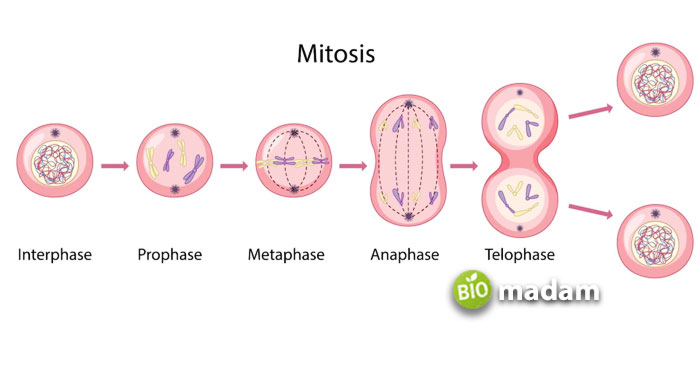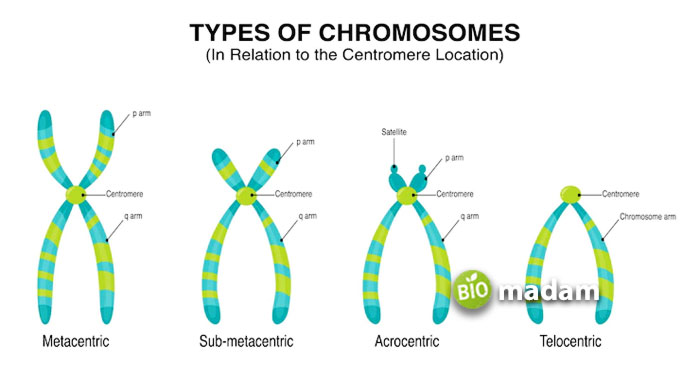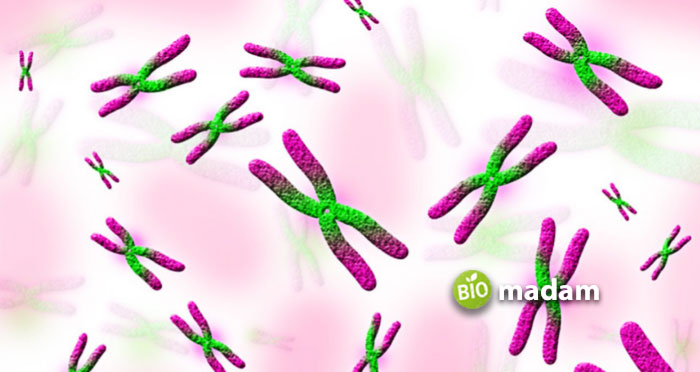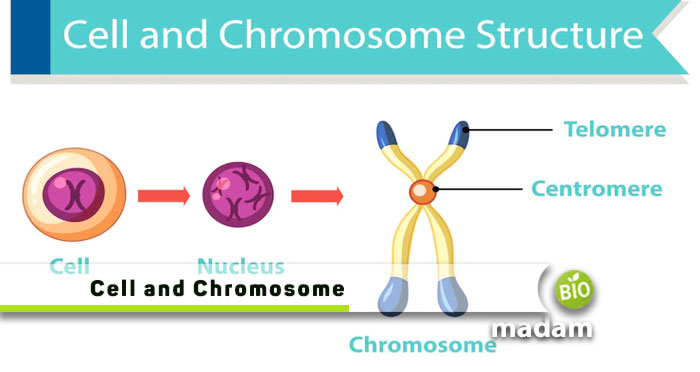Genetic materials, including DNA, RNA, and chromosomes, are essential for survival and reproduction. They carry information about the characteristics and body form of an organism. Chromosomes carry information through replication in prokaryotic and eukaryotic cells from the parents to the daughter cells. Thus, daughter cells acquire some characteristics from their parents called ‘hereditary’ or ‘genetic’ features.
Let’s tell you everything about chromosomes and the types of chromosomes in humans.
What are Chromosomes?
Chromosomes are typically X-shaped structures within the nucleus of the cell.
Humans have 46 chromosomes in pairs, making 23 pairs of chromosomes. 22 pairs of chromosomes determine the genotype and phenotype of the offspring except for the gender. Similarly, the sex chromosomes are further categorized as either X or Y chromosomes, which is the 23rd pair. Males and females are identified through XX, in females, and XY, in males. Each of the chromosome pairs has one chromosome from each parent.
Chromosomes comprise two segments joined at the centromere. The arrangement of chromosomes during replication ensures equal division of DNA between cells. They contain genes and alleles that have the instructions for different processes in the body.
Chromosomes in Prokaryotic and Eukaryotic Cells
Before we talk about the different types of chromosomes with respect to centromeres, here’s how chromosomes in prokaryotes and eukaryotes differ.
Prokaryotic cells do not have as detailed chromosomes as eukaryotes. Their DNA is usually dispersed in the cytosol or cytoplasm in the nucleoid region. Prokaryotic cells only have the euchromatin that forms a single circular chromosome. Some bacteria and other parasites also have linear chromosomes.
On the contrary, eukaryotic cells contain heterochromatin and euchromatin. Eukaryotic chromosomes have a linear DNA double helix structure and appear as long, thin threads. The well-formed chromosomes are visible during the metaphase of mitosis.
Each chromosome contains a centromere that distinguishes it into two segments. Molecular biologists categorize chromosomes on the basis of centromere position.

What is a Centromere?
A centromere is a constricted part of the chromosome that divides into a short arm (p) and a long arm (q). It is a unique DNA sequence in the chromosome that holds the sister chromatids together. The centromeres facilitate proper alignment and separation of chromosomes during cell division in all types of eukaryotic cells.
They play an important function in producing new cells, acting as the binding site for the replicated chromosomes. Centromeres offer a point of attachment for kinetochores and help in the attachment of spindle fiber.
Types of Chromosomes According to Position of Centromere
The position of the centromere plays a major role in determining the type of chromosomes. Chromosomes are categorized into four types based on the centromere’s position: metacentric, submetacentric, telocentric, and acrocentric.

Metacentric Chromosomes
Metacentric chromosomes have the centromere present between the two arms, dividing them into two equals. The chromosome attains a V shape during the anaphase as the p and q arms look equally the same. Thus, the shape of these chromosomes comes out X-shaped.
In humans, chromosomes 1, 3, 16, 19, and 20 are metacentric chromosomes.
Submetacentric Chromosomes
Submetacentric chromosomes form when the centromere is present near the middle but not exactly at the center. The presence of the kinetochore in the sub-median position divides it into two unequal arms. Eventually, they look more like an L than the X-shape of metacentric chromosomes.
Chromosomes 2, 4, 5, 6, 7, 8, 9, 10, 11, 12, 17, 18, and X chromosomes are submetacentric in formation.
Telocentric Chromosomes
These chromosomes have centromeres at the end of the arm and appear as the letter ‘i’ during anaphase. They are also known as the monarchical chromosomes, as the shorter p arm is usually not visible. Telocentric chromosomes give a rod-like appearance. However, mitosis and meiosis in humans do not involve telocentric chromosomes.
Acrocentric Chromosome
The centromere in acrocentric chromosomes is present at the subterminal position. It means that the centromere is near the end of the chromosome, which forms a very short p arm and long q arm. The short p arm makes it difficult to observe acrocentric chromosomes during replication and division.
Chromosomes 13, 14, 15, 21, 22, and Y chromosomes are acrocentric in nature.
Fun fact: The fusion of two acrocentric chromosomes sometimes leads to the formation of a metacentric chromosome.
Types of Chromosomes According to the Number of Centromeres
Besides the position of the centromere, the number of centromeres also differs in specific chromosomes. Though typically chromosomes are seen to have one centromere, some may not have a centromere, while a few may have multiple centromeres.
There are five types of chromosomes according to the number of centromeres.
Acentric
Acentric chromosomes do not have a centromere. They are produced as a result of chromosome-breaking processes in the cell such as irradiation. These chromosomes do not attach to the mitotic spindle. Ciliates have acentric chromosomes in their nucleus.
Monocentric
These are the most common chromosomes, containing one centromere. They may be metacentric, submetacentric, telocentric, and acrocentric, depending on the position of the centromere. Monocentric chromosomes are widely found in highly repetitive DNA and genes.

Dicentric
Dicentric chromosomes have two centromeres present on their arms. They form after two chromosomal segments having a centromere fuse end to end. However, the chromosomes are unstable and move to opposite sides, eventually losing their acentric fragments. It gives rise to dicentric fragments or chromosomes.
Polycentric
As the name suggests, polycentric chromosomes contain multiple centromeres. They are not found in humans but prevalent in plants.
Holocentric
Holocentric chromosomes refer to a condition in which the entire chromosome acts as a centromere. It is diffused into one and is present along the length of the chromosome. Plants, animals, and fungi sometimes have holocentric chromosomes.
The Bottom Line
The genetic material is vital to forming anatomy and maintaining the physiology of all organisms. Genes, DNA, and chromosomes are all forms of genetic material. The position and number of centromeres give rise to the different types of chromosomes. Chromosomes are metacentric, submetacentric, telocentric, or acrocentric, depending on the position of the centromere. Furthermore, chromosomes could be acentric, monocentric, dicentric, polycentric, or holocentric according to the number of centromeres.
FAQs
What are the 2 main types of chromosomes?
Chromosomes can be categorized into two main types: autosomes and sex chromosomes. Humans have 22 pairs of autosomes and one pair of sex chromosomes.
What are polytene and lampbrush chromosomes?
Polytene and Lampbrush chromosomes are giant chromosomes. Polytene chromosomes are present in salivary glands and some other tissues in insects. On the other hand, Lampbrush chromosomes are found in vertebrates except for mammals, and a few invertebrates.
What is a missing chromosome called?
Humans have 23 pairs of chromosomes, making 46 chromosomes in total. In monosomy, an individual has one chromosome missing in the pair and has only 45 chromosomes.

Anna has completed her degree in Pharmacy from the University of Hawaii. She is serving as a research assistant in a pharmaceutical company. She had a great interest in writing blogs, traveling to different parts of the US, and trying delicious recipes in her spare time.

